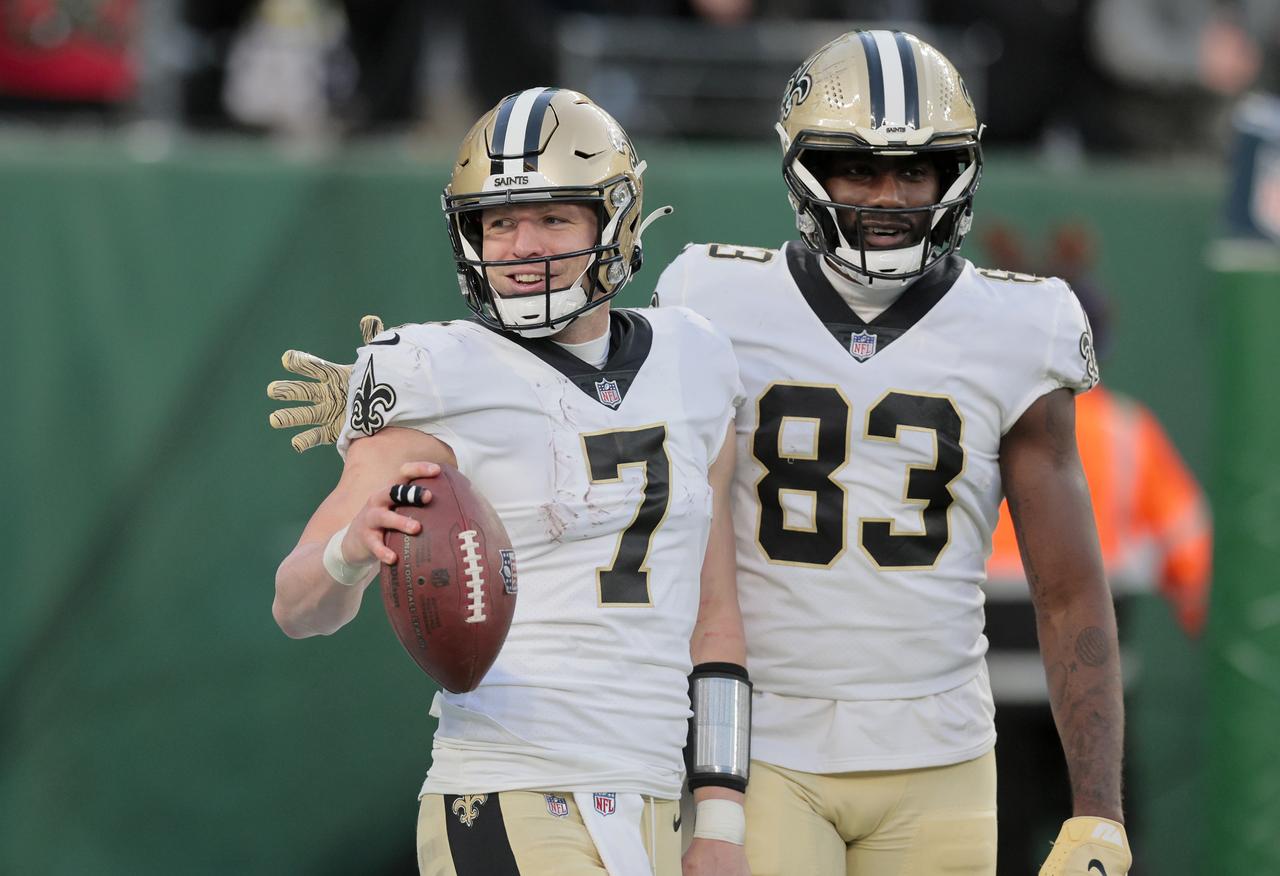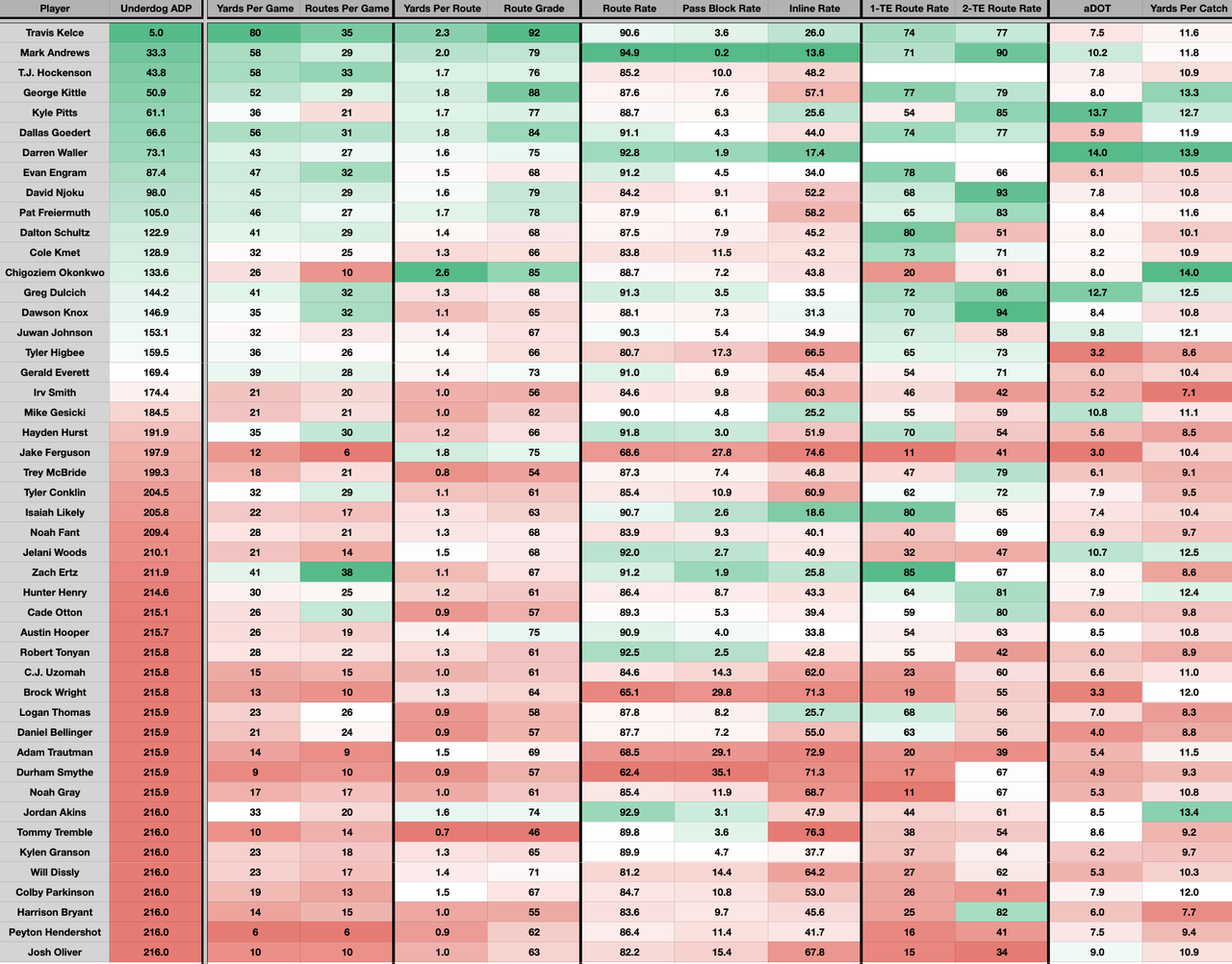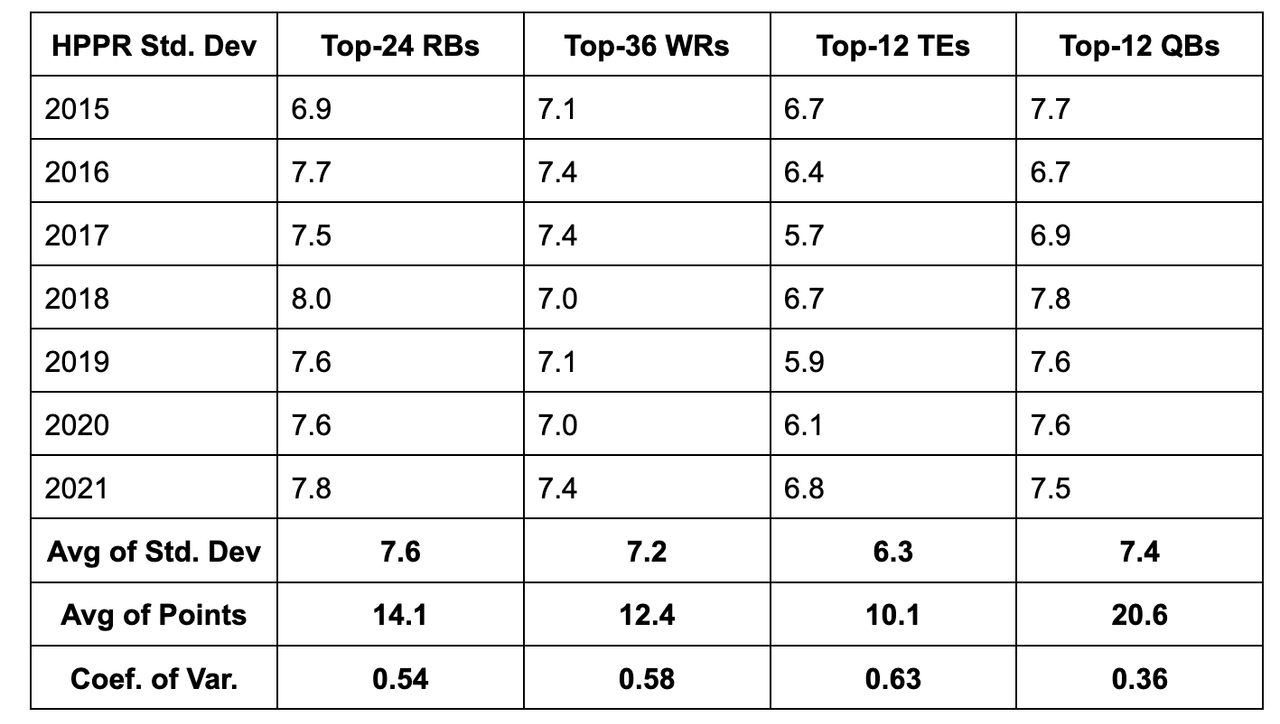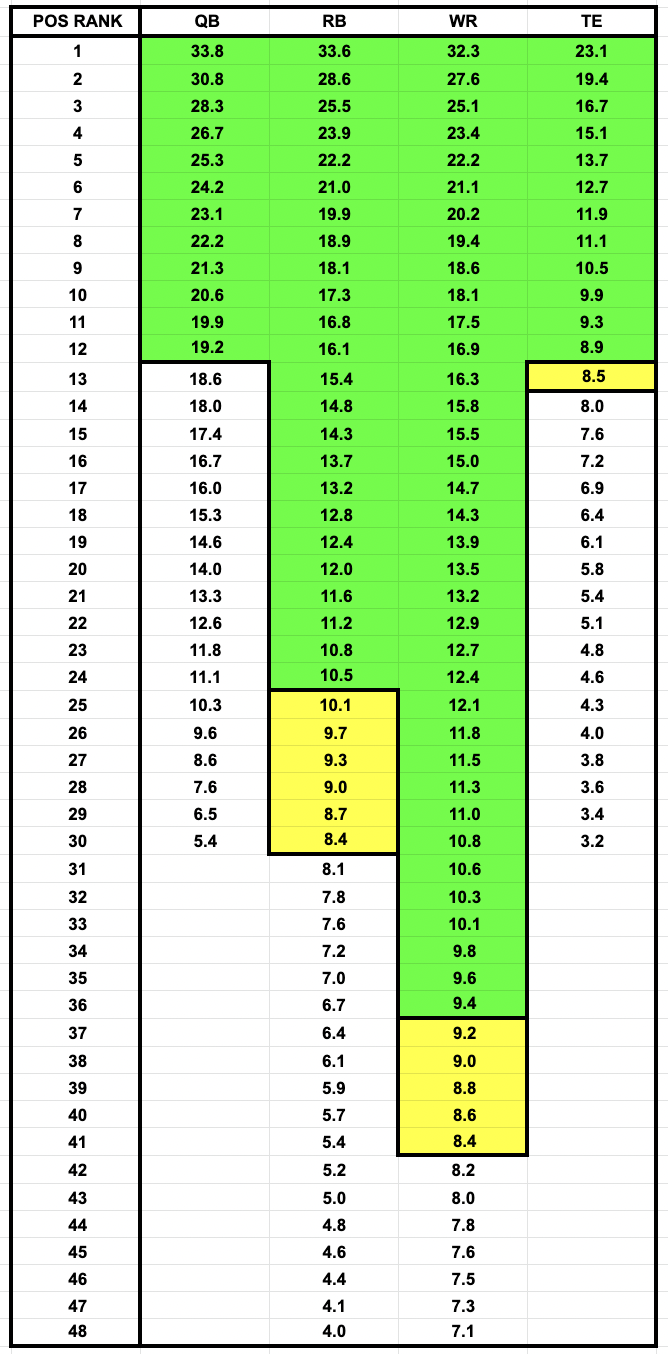The Official Late Round TE Target List

In This TE Data Predicts Fantasy TE Busts, I walked through why this crazy table exists and why there are some early and mid-round TEs that are easy fades at their Underdog Fantasy ADP. This column will be for sickos only, as I pick apart dark web data to find the greasiest boom-bust TE2/3 options for your Best Ball Mania IV teams.

Why Late Round TE In Best Ball
It basically comes down to in-season volatility, pre-season predictability, and some game theory.
Compared to the other positions, TEs are more volatile week-to-week because they're more reliant on touchdowns, rather than the more stable receptions and yards. Not only does that matter for in-season variance, but that fact also makes predicting which TEs are fantasy TE1s vs. TE2s harder before the season, as just 3-4 touchdowns could be the difference of being a good or bad pick (see: 2021 Dawson Knox vs. 2022 Dawson Knox).

This table shows how volatile each position is, in regards to the top players at each position (not in ADP but after the season has played out). If you look at the coefficient of variation metric on the bottom, you'll see the top-12 QBs are far more stable week-to-week than the top-12 TEs, so I'd rather spend 2 roster spots on the consistent position (QB) while spending a 3rd roster spot on the position that can ping-pong usable weeks (TE). I have more on this topic here.
I also don't think the narrative that the elite TEs separate from the rest is actually true after looking at the #math. Last year, Travis Kelce had the 2nd best half PPR season of all time at TE, but his fantasy points over replacement using Underdog Fantasy scoring checked in at 13th overall. Of the top-500 weekly scores last year, he only had 3 of them ... because going off at TE means getting 20 half PPR points, while going off at QB, RB, or WR means getting 30 half PPR points.
That's a simple point, but the harder thing to grasp is that while the TE12 each week feels gross, it's not all that different than the RB30 or WR40 each week. We have to fill 2 RBs, 3 WRs, and a flex spot that's typically used by a RB or WR, so Cooper Kupp's 30-burger hits harder than some realize. Here's how much the top player at each position separated from their positional replacement on average each week:
QB: +14.6 half PPR points
RB: +25.2 half PPR points
WR: +23.9 half PPR points
TE: +14.6 half PPR points

Lastly, there's some game theory aspects I like about late round TE. Because QBs score more points and are more predictable pre-season, I like to prioritize the early-round QBs and then add the correlation of their TEs afterwards. If I'm right about the QB going off, then I'll just ride the wave of his passing TDs at TE.
Then there's the fragility of the elite TE1 landscape. There are only so many TEs who have the talent, role, and offense that can create a true difference-making season. Right now, I think that short list is just Kelce and Mark Andrews, so if Kelce misses time or starts declining, then the entire late-round TE strategy takes a massive win. There simply would be fewer 15+ point games at the position, so all it takes is 1-2 things breaking a certain way for an entire strategy to go right! That phenomenon is far less likely at QB where there are arguably 5 potential elites, WR where there are arguably 7-10 elites, or RB where there are arguably 5-11 elites.
But I digress. People just want the player takes. So let's dive in.
Late Round TE Targets
I have player blurbs for the top-12 TEs in ADP here.
Juwan Johnson - He is my underrated TE2. The Saints' depth chart features Johnson, Taysom Hill (51 inline snaps last year), and undrafted players. Johnson, who is a converted WR-to-TE, should play more inline snaps with Adam Trautman traded. Last year, he only had 23 routes per game but with a worse depth chart and Derek Carr likely making New Orleans more pass heavy, Johnson's route volume likely ticks up. His 9.8 average depth of target is a function of his WR background, too. I like his odds of boom-bust TE2 production at cost, especially after New Orleans signed him to a 2-year, $12M contract this offseason despite being a restricted free agent.
Michael Mayer - If you watched our prospect video on Mayer, you'd know that he offers more receiving versatility (and slightly worse blocking) than the narratives surrounding his skillset. Last college season, he was 3rd in TE targets as an inline TE and was 2nd in TE targets from slot/wide per SIS. He also led in targets off of motion. Last year, the Raiders asked Darren Waller to block just 2% of the time, while lining up inline on just 17% of passing down snaps. The latter was a steep drop from his baseline 50% rate. Even going back to New England, coach Josh McDaniels is willing to put his TEs in the slot and out wide, so I like the fit for Mayer. He'll be backed up by veteran inline TE Austin Hooper, who only secured a one-year, $2.7M contract this offseason. If Mayer is any good, he has a path to TE1/2 volume as Jimmy G tends to throw the ball underneath. I'm in.
Luke Musgrave - I'm very intrigued. He's not loved by the fantasy streets because limited college production due to injuries, but Musgrave has the size, athleticism, draft capital, and weak target competition that can lead to fantasy breakouts. He has 86th percentile height and 55th percentile weight, while still showcasing a 93rd percentile ten-yard split, 90th percentile broad jump, and 60th percentile three cone. The Packers used the 43rd overall pick on him, following that up with the 79th overall pick on Tucker Kraft. That'll be his primary competition for snaps because Josiah Deguara (6'2/238) is small role TE only. Both Musgrave and Kraft lined up inline on 58% of their college snaps and have nearly identical body types. This is a pure skill based competition, with Musgrave as a big favorite due to draft capital. On a very small sample last year, Musgrave happened to flash a 3.4 yards per route run average.
Sam LaPorta - Unlike other Iowa TEs, LaPorta only lined up inline on 48% of his senior snaps. He was 3rd in targets from the slot or out wide among all college TEs last year, leading to the 2nd most broken tackles forced. LaPorta should beat out 2022 5th-rounder James Mitchell for receiving duties, while 6'5/255 inline TE Brock Wright could be favored for some blocking duties. The latter part is key, as LaPorta has 11th percentile height and 19th percentile weight. If he's not playing enough 1-TE sets, then he'll be capped in fantasy. This is what I'll be tracking in training camp and the preseason. For now, I'm just fine with him in fantasy.
Jake Ferguson - He has a massive range of outcomes, but he has the size (6'5/255), receiving chops, and offense to give him top-15 fantasy TE paths. Buried behind Dalton Schultz last year, Ferguson was used as an inline blocker while Schultz ran more routes in 2-TE sets. I'm willing to throw out Ferguson's worrisome 28% pass-blocking rate from his rookie season, as he was subbed in for traditional blocking looks in 2-TE sets last year. The 4th-rounder flashed some skills as a low-volume receiver in college and as a rookie; Ferguson's 1.8 yards per route run and 75.2 PFF receiving grade are very solid. Behind him, 2nd-round rookie Luke Schoonmaker is viewed as a blocking type with 48th percentile adjusted college production per my metrics. If Ferguson is in a version of the Schultz role, he will be running more routes while Schoonmaker slides into this blocking-heavy TE2 role. I'm in on Ferguson.
Tyler Higbee - Last year was a relative disaster for some reasons Higbee couldn't control. The Rams OL was massively banged up, particularly at OT. That possibly explains why Higbee's pass blocking rate went from 9% in 2021 up to an alarming 18% last year. If the OTs can hold up and if the play-calling leans more pass-heavy with Matthew Stafford returning, Higbee could increase his route volume by close to 100. There's little target competition aside from Cooper Kupp now, too.
Taysom Hill - The "Taysom could start games at QB" narrative is likely dead this year with Derek Carr and Jameis Winston ahead of him, so Hill's 2023 projection is largely determined by gadget plays. Last year, he finished as the TE5 on a career high 6.0 carries per game. I don't think that holds. While Alvin Kamara certainly could miss 6ish games due to suspension, Hill faces steep competition at the goal line with Gyration King Jamaal Williams and size/speed rookie Kendre Miller in the fold. 29% of Hill's fantasy points last year came on red zone rushes. Without them, he would've been the TE16. Hill is also further removed from Sean Payton (who was his biggest advocate), so his 79 non-red zone carries could take a hit, too. In other words, why pay Carr all that money to sub him out for gadgetry? That leaves me with one final out: TE snaps. The depth chart behind Juwan Johnson is brutal. Hill only played 51 inline snaps last year because he's 221 pounds, however. He simply can't hold up there, so he'll need to be motioned out into the slot or play some play-action fullback to run routes. Even then, he only had a 0.6 yards per route run rate last year when target competition wasn't as strong (Michael Thomas returns). Anything is possible in fantasy land, but I view a repeat of Hill's 2022 season as quite unlikely. I like the breakout odds of other TE2/3s more.
Hayden Hurst - He's an average talent, but Hurst signed a decent 3-year, $22M contract with $13M guaranteed to be the Panthers' unquestioned starter. In Cincy last year, Hurst ran a route on a strong 92% of his passing snaps. He has the size to stay into block or line up inline (52%), but the NFL seems to like his receiving skills more than we do in fantasy. His backups (Ian Thomas and Tommy Tremble) are cheap blocking types, so Hurst likely sees more volume than expected, meaning he has easy paths to TE2 value even if he's pretty much closed off from TE1 production unless Bryce Young is truly him. Hurst is totally fine in the last rounds.
Mike Gesicki vs. Hunter Henry - First off, Henry has the second highest cap hit ($15.5M) of any TE in 2023. Gesicki is only at $4.5M. That's a hint!!! Henry only ran 25 routes per game last year because the Patriots offense was unwatchable under Matt Patricia, but he did at least run a route on 64% of 1-TE set dropbacks and 81% of 2-TE set dropbacks. Both of those are right at the thresholds I look for. Meanwhile, Gesicki was at 55% and 59% respectively last year. Henry won't lose many snaps to Gesicki because he's a much better blocker, and if the Patriots use more 2-TE sets this year, Henry still will be out in the route against relatively poor pass-catchers. I like Henry straight up, especially while cheaply adding some Patriots as a bet against the pencil ear god.
Trey McBride - Zach Ertz is paid handsomely, but he's likely not rushing back from a multi-ligament knee tear in his age-33 season. McBride will be playing for one of the worst teams in the league, but his 2nd-round draft capital gives him playing time if he's any good at all. Last year was a struggle, however. He only had a 0.8 yards per route run with an iffy 54.0 PFF receiving grade. He'll need a 2nd-year improvement to make a difference. With that said, he ran a route on 77% of the Cardinals 1-TE sets in Weeks 10-18 after Ertz went to injured reserve. McBride will pass TE1/2 volume thresholds as a last round dart throw. I just wish I liked the Cardinals and his tape more.
Tyler Conklin - He's quietly in the middle of a 3-year, $20M contract. He also quietly ran 29 routes per game, so with Aaron Rodgers upgrading the passing numbers of the offense, I'm optimistic Conklin can be a TE2 as a last-round best ball pick. He won't fully make a difference until his mediocre 87% route rate and way-too-high 60% inline rate improves, however. This is a small win, small loss selection. I'll mix him in when game stacking the Jets.
Cade Otton - He ran 30 routes per game last year as a rookie. Impressive! The Bucs won't dropback to pass as much as last year, but Otton is a safe bet for TE2-level routes. He only blocked on 5% of his passing snaps last year, while playing inline on a normal 39% of his overall snaps. His competition for snaps are from 6th-rounders and UDFAs. If Chris Godwin and/or Mike Evans miss time via injury or trade, Otton's path to targets eases up. His 0.9 yards per route run and 57.0 PFF receiving grade keep his ceiling low even if that were to happen, however.
Jelani Woods - A great athlete with little experience, Woods flashed on his limited rookie routes (14 per game). He averaged a solid 1.5 yards per route run and only blocked on 3% of his passing downs. Heading into year two, there's some buzz here. It's only somewhat warranted, however. The Colts will likely be at the bottom of the league in passing production with rookie year Anthony Richardson, and Woods likely finds himself in a rotation again. He simply hasn't figured out blocking yet (33.1 PFF blocking grade), while Mo Alie-Cox (65.7) holds his own thanks to his 6'5/267 frame. Throw in Kylen Granson's 18 routes per game and we're in TD-or-bust territory with Woods.
Isaiah Likely - He only ran 17 routes per game in an offense that could scale back their 2-TE set looks with pass-heavy OC Todd Monken coming in. Likely most likely goes unheard from for weeks, but he's a legitimate insurance option if Mark Andrews misses time. Likely ran a route on an elite 91% of his passing snaps and lined up inline on just 19% of his snaps. The latter is a minor issue, as he doesn't have the body type (6'4/241) of an every-down option. He played above 75% of the snaps in games Andrews missed last year. That's decent. I view him as a dart throw in 3-TE builds only.
Noah Gray - This is the same thought process as Likely, but with the Chiefs. Gray is in the final year of his rookie deal behind a 34-year-old Kelce, who has completely blocked him from 1-TE set participation. When the Chiefs are in 2-TE sets, Gray at least runs a route on 67% of dropbacks. If something happens to Kelce this year, Gray likely goes from 17 to near 30 routes per game in an offense led by Patrick Mahomes. In large field best ball tournaments, you can go worse than adding Gray as a dart throw TE3.
Irv Smith - I'm out at cost. He's been injured for years, possibly because he's only 6'2/242, but there's very weak competition at TE in Cincy. Smith has a career 1.1 yards per route run rate, so overall receiving talent is an issue, meaning he really needs to get the right role or run extremely hot on TDs to matter in fantasy. In his 7 healthy games last year before the T.J. Hockenson trade in Minnestoa, he only ran a route on 51% of the team's 1-TE set dropbacks. The reason for that forgettable rate is likely poor blocking skills preventing him from being the only tight end on the field. The same is true for the Vikings' 2-TE sets, where he ran a route on just 13-of-23 dropbacks last year. If healthy, Smith will be the top receiving option for Joe Burrow, but he hasn't shown the ability to handle a full-time role because of his lack of size. I expect blocking-type Drew Sample (6'5/255) to mix in. I won't be chasing Smith up boards. The Bengals still could add another TE to the mix after only signing Smith ($1.75M) and Sample ($1.1M) to one-year contracts this offseason.